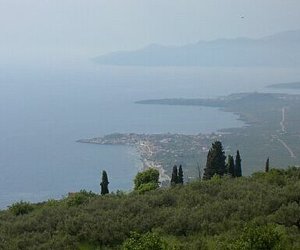Mani Peninsula
|
|
GreeceMani.png
For other meanings of the word Mani, see Mani.
The Mani Peninsula is a region in Greece. The Mani is the central peninsula of the three which extend southwards from the Peloponnese in southern Greece. To the east is the Laconian Gulf, to the west the Messenian Gulf. The peninsula forms a continuation of the Taygetos mountain range, the western spine of the Peloponnese.
The terrain is mountainous and inaccessible. The name "Mani" is thought to have originally meant "dry" or "treeless." Until recent years many Mani villages could be reached only by sea. Today a narrow and winding road extends down the west coast from Kalamata to Areopoli, but on the east coast there is no substantial road south of Gytheio.
Administratively, The Mani is divided between the districts of Laconia and Messenia, in the province of Peloponnesos, but in ancient times it lay entirely within Laconia, the district dominated by Sparta. The Messenian Mani receives somewhat more rainfall than the Laconian, and is consequently more fertile. Messenian Maniot surnames almost uniformly end in -eas, whereas Laconian Maniot ones in -akos.
Neolithic remains have been found in the many caves along the Mani coasts. Homer refers to a number of towns in the Mani region, and some artifacts from the Mycenean period have been found. The area was occupied by the Dorians in about 1200 BC, and became a dependency of Sparta. When Spartan power was destroyed in the 3rd century, the Mani was self-governing for a time before being absorbed into the Roman Empire in the 2nd century.
As the power of the Byzantine Empire declined in the 9th century AD, the peninsula drifted out of the Empire's control. The fortress of Maini in the south became the area's centre. Over the subsequent centuries the peninsula was fought over by the Byzantines, the Franks and the Saracens.
After the fall of Constantinople to the Fourth Crusade in 1204, Italian and French knights (known to the Greeks as Franks), occupied parts of the Peloponnese. In 1249 the Mani was occupied by the Venetians, who made it one of the twelve baronies of the Principality of Moreas and built the fortresses of Mystras, Passavas, Gustema (Beaufort) and Megali Maini.
In 1460 Mystras fell to the Ottomans, but the Mani was not subdued and retained its internal self-government in exchange for an annual tribute. Local chieftains or beys governed Mani on behalf of the Ottomans. As Ottoman power declined, the mountains of the Mani became a stronghold of the kleftes, bandits who also fought against the Ottomans. There is evidence of a sizeable Maniot emigration to Sardinia sometime during the Ottoman years.
The last bey of Mani, Petros Mavromichalis was among the leaders of the Greek War of Independence. He proclaimed the revolution at Areopoli on 17 March 1821. The Maniots contributed greatly to the struggle, but once Greek independence was won they wanted to retain their local autonomy. During the reign of Ioannis Kapodistrias they violently resisted outside interference.
The Mani's local autonomy was abolished in 1870, and the area gradually became a backwater as the inhabitants abandoned the land through emigration. It was not until the 1970s, when new roads led to the growth of the tourist industry, that the Mani began to regain population and become prosperous. Maniots were known for their obstinate character, conservative views, sometimes extreme frugality, and their zealous safeguarding of the family property.
Despite the region's aridity, Mani is known for unique culinary products such as glina or syglino (pork or pork sausage smoked with aromatic herbs such as thyme, oregano, mint, etc. and stored in lard along with orange peel), and what is probably the world's best extra-virgin olive oil, soft-pressed from partially ripened olives of the Koroneiki varietal that are organically grown on mountain terraces.
Today the Mani's coastal villages are full of cafes and souvenir shops. The peninsula attracts visitors for its Byzantine churches, Frankish castles and stunning scenery. Furthermore, the famous towers of Mani are significant tourist attractions. Gytheio, Areopoli, Kardamyli and Stoupa are filled with German and other tourists during the summer months.

